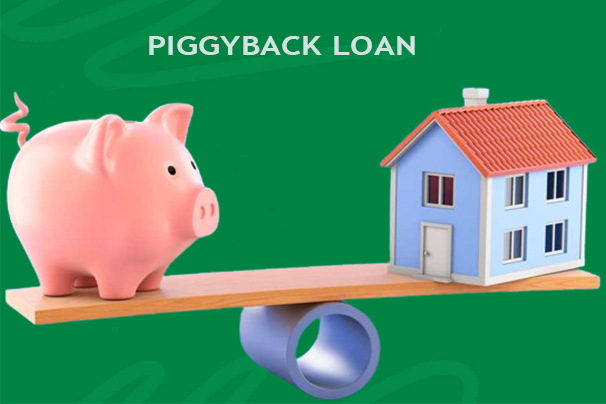A piggyback loan, also known as an “80/10/10 loan,” involves taking out two loans simultaneously to finance a home purchase. The primary mortgage typically covers 80% of the home price, while the second mortgage, often a HELOC, covers 10%, with the remaining 10% covered by the down payment. This structure allows borrowers to simulate a 20% down payment with only 10% out of pocket, leading to lower rates and avoiding private mortgage insurance (PMI).
Piggyback loans offer benefits such as lower interest rates, no PMI, and smaller loan sizes, enabling buyers to stay within conforming loan limits and avoid jumbo loans. However, they come with challenges like qualifying for two loans, higher rates on the second mortgage, and potential refinancing complexities. Piggyback loans can be advantageous for certain buyers seeking to optimize their home financing strategy. They provide benefits like avoiding PMI, lower down payments, and convenience in closing both mortgages simultaneously.

Additionally, piggyback loans can help buyers finance more than 80% of a home’s purchase price without resorting to jumbo loans. However, qualifying for a piggyback loan may be challenging due to higher debt-to-income requirements and the need for good credit. Despite the advantages, borrowers should carefully consider the costs and potential refinancing difficulties associated with piggyback loans before opting for this financing option.
How Does It Work?
A piggyback loan, also known as an “80/10/10 loan,” is a financing strategy that involves taking out two separate loans simultaneously to purchase a home. The primary mortgage covers 80% of the home’s purchase price, while the second mortgage, or “piggyback,” covers 10%. The remaining 10% is covered by a cash down payment from the borrower. This structure allows borrowers to simulate a 20% down payment with only 10% out of pocket, which can result in lower interest rates, no private mortgage insurance (PMI), and smaller loan sizes.
Piggyback loans can be advantageous for buyers who want to avoid PMI, lower their down payments, or finance more than 80% of the home’s purchase price without resorting to jumbo loans. They can also offer convenience by closing both loans at the same time, avoiding the need for two separate sets of paperwork and closing costs. However, borrowers should consider the challenges associated with qualifying for two loans, potentially higher rates on the second mortgage, and potential refinancing complexities before opting for a piggyback loan.
Types of Piggyback Loans
There are several types of piggyback loans that borrowers can consider based on their financial situation and needs:
80-10-10 Loan:
This is one of the most common types of piggyback loans, where the first mortgage covers 80% of the purchase price, the second mortgage covers 10%, and the borrower provides a 10% cash down payment. By combining the second mortgage with the down payment, borrowers achieve a total of 20% down payment to avoid PMI.
80-15-5 Loan:
Similar to the 80-10-10 loan, this option is suitable for borrowers who have around 5% for a down payment instead of 10%. The first mortgage covers 80% of the home’s value, while the second mortgage covers up to 15%. The remaining 5% is paid as a down payment. It can be helpful for borrowers who want to avoid paying private mortgage insurance (PMI).
75-15-10 Loan:
This type of piggyback loan is commonly used for condominium purchases, especially when interest rates on condos are higher and you are borrowing more than 75% of the purchase price. It involves a primary mortgage covering 75%, a second mortgage covering 15%, and a 10% down payment.
Why Qualifying for a Piggyback Loan May Be Challenging
Qualifying for a piggyback loan may be challenging due to several factors outlined in the search results:
Credit Score Requirements:
Lenders typically require a good credit score to qualify for a piggyback loan. Borrowers need a credit score of at least 700, with higher scores like 740 or above increasing the likelihood of approval. A strong credit history is crucial, and some lenders may even look for scores in the high 600s to approve a piggyback loan application.
Debt-to-Income Ratio:
Borrowers must meet specific debt-to-income (DTI) ratio requirements, usually not exceeding 43%, after considering payments for both primary and secondary mortgage loans. This means that monthly debt payments, including both loans, should be less than 43% of the borrower’s gross monthly income, similar to the requirements for traditional mortgages.
Complex Application Process:
Applying for a piggyback loan involves meeting the requirements of two separate loans, which can complicate the process. Borrowers need to qualify for both loans individually, leading to separate closings with associated expenses like origination fees, home appraisals, and legal fees.
Potential Risks:
While piggyback loans offer benefits like avoiding PMI and lower down payments, borrowers should consider potential risks such as higher interest rates on the second mortgage, refinancing complexities, and the possibility of losing the house if they are unable to keep up with payments on either loan.
Pros and cons of Piggyback Loan
Pros
Avoiding PMI:
Piggyback loans allow borrowers to avoid paying for private mortgage insurance (PMI) by reaching a 20% down payment through a combination of two loans.
Lower monthly payments:
By spreading the cost of the home across two loans, borrowers can benefit from lower monthly mortgage payments compared to a single loan with PMI.
No Jumbo Mortgage:
Piggyback loans enable buyers to stay within conforming loan limits, avoiding the need for more expensive jumbo mortgages.
Tax Benefits:
Interest paid on the second mortgage may be tax-deductible, providing potential tax advantages for borrowers.
Cons
Qualification Challenges:
Qualifying for two loans can be difficult due to credit score requirements, debt-to-income ratios, and the complexity of managing two separate loans.
Higher Interest Rates:
The second mortgage in a piggyback loan often carries a higher interest rate than the primary mortgage, potentially leading to higher overall costs.
Refinancing Complexity:
Refinancing a piggyback loan can be more complicated as the second-lien holder must agree to take a subordinate position to the primary mortgage lender.
Additional Costs:
Borrowers incur double closing costs when taking out two loans, including origination fees and administrative charges, which can increase the overall expense of the loan.
FAQs
Are piggyback loans a good idea?
In many cases, piggyback loans can offer benefits like lower monthly payments and faster equity building compared to traditional mortgages with PMI. However, deciding whether a piggyback loan is suitable involves considering various factors such as credit score, interest rates on each mortgage, closing fees, and the total borrowing costs of each loan option. It’s essential to evaluate all aspects before determining if a piggyback loan aligns with your financial goals.
Can I use a piggyback loan for a refinance?
Yes, piggyback loans can be used for refinancing existing mortgages. Borrowers can utilize this strategy to access equity in their homes, consolidate debt, or secure a lower interest rate. However, it’s essential to assess the costs, interest rates, and overall financial implications of refinancing with a piggyback loan to ensure it aligns with your financial goals and circumstances.
What are the advantages of a piggyback loan over PMI?
Piggyback loans offer several advantages over private mortgage insurance (PMI), including potentially lower monthly payments, tax-deductible interest on the second mortgage, and the ability to avoid PMI premiums. Additionally, piggyback loans can help borrowers reach a 20% down payment without saving a large sum upfront, enabling them to secure more favorable loan terms and potentially save money over the long term.
Are there risks associated with piggyback loans?
While piggyback loans provide benefits like avoiding PMI and reducing down payment requirements, they also come with risks. These risks include higher interest rates on the second mortgage, potential difficulty in refinancing both loans and the possibility of foreclosure if borrowers struggle to meet payments on either loan. It’s crucial for borrowers to carefully weigh these risks against the benefits before committing to a piggyback loan.
How do I qualify for a piggyback loan?
Qualifying for a piggyback loan involves meeting specific criteria such as good credit scores, manageable debt-to-income ratios, and demonstrating financial stability. Lenders may have varying requirements for piggyback loans, so it’s advisable to consult with a mortgage professional to assess your eligibility and explore the best financing options based on your financial situation and goals.
